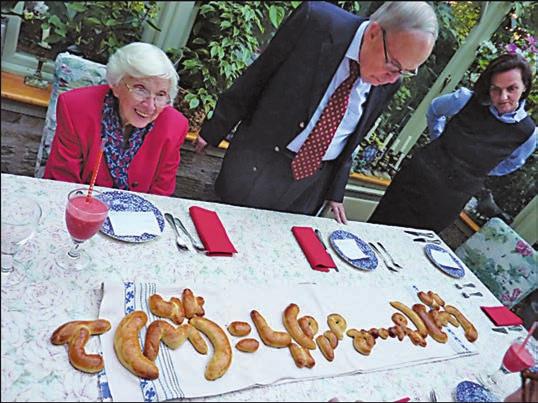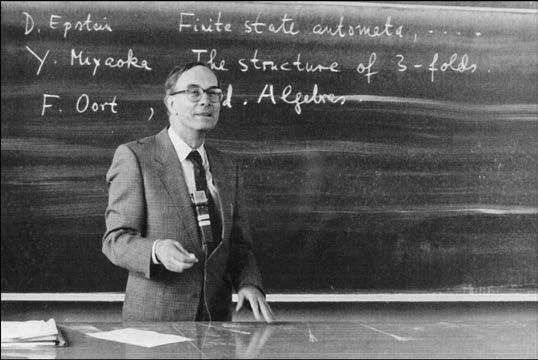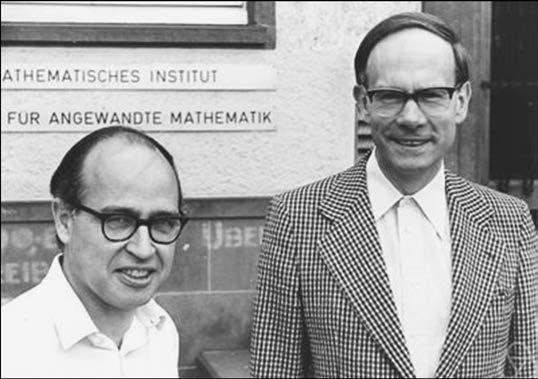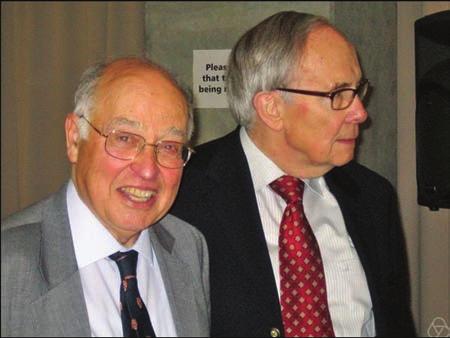by Michael Atiyah
Fritz Hirzebruch played a major part in my life, particularly over the early formative period. He became a close personal friend, a long-term collaborator, and, through the Arbeitstagung, my introduction to the mathematical world. I learned a good deal from him on how to write papers, how to present talks, and, most importantly, how to handle people. In short, he was an ideal role model.
I first met Fritz in 1954 when I was a young graduate student and he visited Cambridge at the invitation of Hodge, my supervisor. Hodge and Todd had been much impressed by what Fritz had been doing at Princeton and were keen to be briefed on the Riemann–Roch Theorem and Chern classes. What I remember about the occasion is how friendly and informal Fritz was. Although he was already an assistant professor at Princeton and I was merely a graduate student, there were no barriers between us, and we quickly established a friendship which blossomed over the subsequent years. We met again at the Amsterdam ICM of 1954 and then, for a longer period, when I went on a postdoctoral fellowship to the Institute for Advanced Study in Princeton.
The Princeton years
Those Princeton years were, for me, for Fritz, and for many others the “golden years”. Algebraic geometry and topology were being transformed by the new ideas of the French School. Sheaves and spectral sequences from Leray combined with complex analysis by Henri Cartan produced powerful machinery to tackle classical problems. This was taken up by Kodaira and Spencer, while Serre burst on the scene with spectacular applications to both algebraic topology and algebraic geometry. When I arrived in September 1955, brilliant young mathematicians were absorbing the new ideas and carving out new routes for the future. I remember in particular the gang who regularly attended Kodaira’s lectures: Fritz, Serre, Bott, Singer.
This had been for Fritz the experience that transformed him from a promising novice to a world figure capable of competing with the greatest talents of the time. Within a short period of time he came up with two great triumphs. Both were based on the innovative way of associating multiplicative classes to formal power series in one variable. First there was his formula \begin{equation*} \operatorname{Sign}(M) = \int_M \mathcal{L}(M) = \int_M \prod^n_{i=1} \frac{x_i}{\operatorname{tanh}x_i},\quad \text{where (formally) } p(M) = \prod^n_{i=1} (1+x^2_i) \end{equation*} for the signature of a 4\( n \)-dimensional manifold in terms of the Pontrjagin classes \( p_j (M) \). This was a beautiful application of Thom’s new cobordism theory. But Fritz’s second triumph, his generalization (now known as “HRR” or Hirzebruch–Riemann–Roch) \begin{equation*} \chi (X,V) = \int_X \mathrm{ch}(V)\, \mathrm{Td}(X) \end{equation*} of the Riemann–Roch Theorem, was even more impressive. Here \[ \chi (X, V ) = \sigma \quad (\text{from }q = 1 \text{ to } q = m) \text{ of }(-1)^q \dim H^q (X, V ) \] is the holomorphic Euler characteristic \( \sum_{q=0}^m \dim H^q (X, V ) \) of the sheaf cohomology groups of a holomorphic vector bundle \( V \) (of dimension \( d \)) over a complex projective algebraic manifold \( X \) of dimension \( m \). The Chern character is defined in terms of the total Chern class \( c(V ) \) by \begin{equation*} \mathrm{ch} (V) = \sum^d_{i=1} e^{x_i},\quad \text{where (formally) } c(V) = \prod^d_{i=1} (1+\chi_i), \end{equation*} and the Todd class \( T d(X) \) is defined similarly in terms of the total Chern class \( c(X) \) of the tangent bundle of \( X \) by \begin{equation*} \mathrm{Td}(X) = \prod^m_{j=1} \frac{y_j}{1-e^{-y_j}}, \quad \text{where (formally) } c(X) = \prod^m_{j=1} (1+y_j). \end{equation*} Of course HRR built on fundamental work by Kodaira, Spencer, and Serre, but the proof was a tour de force that had the hallmark of Fritz’s own mathematical style.
Characteristic classes had been developing for many years, from the algebraic geometry of the Italian School through significant advances by Todd and the later topological approach of Steenrod and Chern. But all this emphasized their geometrical origin and significance. It was Fritz, in collaboration with Borel, who took the dual route of cohomology and, connecting it to the theory of Lie groups, gave Chern classes their formal algebraic setting, which has now become standard. With his command of this algebra and with his insight into the right algebraic framework, Fritz had developed his theory of multiplicative sequences, which provided the right tools to tame the horrendous-looking formulae.

When Todd, no slouch at algebraic computations, had computed the first half dozen “Todd polynomials”, it had been a matter of brute force. In the hands of Fritz as “magician” the calculations became elegant and transparent. After seeing this, Todd remarked that he now had to reverse the earlier view he had held of the “Princeton School” that, while they might be good at general theory, they were not adept at calculations. The old maestro conceded defeat to the young contender.
It was fortunate for the new generation like me, eager to learn about the great advances in algebraic geometry, that Fritz was also a brilliant expositor. His book Neue Topologische Methoden in der Algebraischen Geometrie (Springer, 1956) gave an impeccably clear account of sheaf theory, Chern classes, and all the new machinery that culminated in the Hirzebruch–Riemann–Roch Theorem. The book and its subsequent English edition Topological Methods in Algebraic Geometry (with appendices by R. L. E. Schwarzenberger, one of my early students) has remained the standard work for over fifty years.
The early Arbeitstagungs

When Fritz returned to Germany as a full professor at the University of Bonn, a new day dawned for German mathematics. With his enthusiasm, ability, efficiency and drive, Fritz soon transformed Bonn into a major center of the mathematical world. Modelled on Princeton, it aimed to introduce into Europe the features that had so attracted Fritz and others across the Atlantic.
Because of the friendship I had forged with Fritz in Princeton and because of the proximity of Cambridge to Bonn, I was fortunate to have been invited to the very first of the annual meetings that became the famous Arbeitstagung. I went on attending these meetings for almost thirty years. It became an obligatory part of the academic calendar where new results were announced, many famous mathematicians regularly attended, and the whole event was under the careful but loving care of the “maestro”. Fritz’s talents were fully exploited, but not exposed, in these annual gatherings. With their relaxed atmosphere, the Rhine cruises and the skillful selection of speakers by what has been described as “guided democracy”, the Arbeitstagungs were unique. Happy family gatherings they may have been, but much serious mathematics was always being presented and fostered. Ideas flowed, collaborations emerged, and successive years reflected the latest movements.
Moreover, as the years passed, Fritz was always keen to attract new talent, and he encouraged me to send promising graduate students to attend. I was happy to respond, and, over the years, my students were introduced to the international scene through the Arbeitstagung. Graeme Segal, Nigel Hitchin, Simon Donaldson, Frances Kirwan, and many others came and became, in their turn, regular participants.
But if the entire series of Arbeitstagungs became highpoints of the academic calendar, the initial one (in 1957) on a very modest scale was particularly noteworthy for launching Grothendieck. He had just developed his brilliant new approach to the Hirzebruch–Riemann–Roch Theorem, based on \( K \)-theory. I remember him lecturing for many hours on his ideas. In fact he seemed almost to monopolize the timetable, but the novelty and importance of his work fully justified the time devoted to it. The fact that the program was sufficiently generous and flexible to allow this to happen was an early indication of the way Fritz wanted the Arbeitstagungs to work. No set plans, and full steam ahead for novel and exciting mathematics.
Grothendieck’s explosive entry on the scene was a hard act to follow, but the Arbeitstagungs in those early years saw a succession of new and exciting results, including Milnor’s discovery of exotic spheres and their subsequent realization by Brieskorn (a student of Fritz) via isolated singularities of algebraic varieties (a study initiated by Fritz). In fact, so many new ideas filled the Arbeitstagung air that most of my own work (and probably that of many others) emerged from this background. We learned many new things from disparate fields, and cross-fertilization became the norm. I will elaborate on this in the next section.
My collaboration with Fritz
In the three years 1959 to 1962 Fritz and I wrote eight joint papers, all concerned with topological \( K \)-theory and its applications. This had emerged naturally from the early Arbeitstagungs and in particular from Grothendieck’s \( K \)-theory in algebraic geometry, as expounded in the very first Arbeitstagung. But there were many other ingredients in the background, notably the Bott periodicity theorem.
Topological \( K \)-theory was mainly developed by Fritz and me in 1959 when we both had a sabbatical term at the IAS in Princeton. A preliminary account appears in [1], and we planned to write an expanded version in book form. In fact, we never had time for this project, but a book [e1] did eventually appear under my name based on a Harvard course of lectures.

These joint papers are a mixture of general theory and concrete problems. For example, [3] showed that the famous Hodge conjectures were false for integer cohomology (still leaving the case of rational cohomology as one of the Clay Institute Millennium Prize problems). Other papers were related to some of Fritz’s earlier Princeton period, such as his discovery of a relation between Steenrod squares and the Todd polynomials [2]. Some of our joint papers appeared in German (written by Fritz), while others appeared in English (written by either of us), but one appeared in French (written by neither of us!). That one gave bounds on the smallest dimension in which various manifolds could be embedded. While a primitive version was an idea of mine, the final very polished version was an exquisite illustration of Fritz’s elegance with algebraic formulae. But my mathematical interaction with Fritz extended far beyond these joint publications and the three years they cover. Much of my work was influenced in one way or another by Fritz, and a later publication [4] is one of my favorites. Here we proved that a spin manifold that admits a nontrivial circle action has vanishing \( \hat{A} \)-genus. This emerged as a new application of index theory, which first appeared in the Arbeitstagung program of 1962. Fritz took great interest in the development of index theory, which owes so much to his pioneering work.

While our later mathematical paths may appear to have diverged, this is only superficially true. We met frequently in Bonn and elsewhere, and we followed each other’s work with great interest. One notable example is Fritz’s beautiful results on the resolution of the cusp singularities of Hilbert modular surfaces (as explained by Don Zagier). His key result gave the signature defect of such a cusp singularity as the value of a suitable \( L \)-function of the number field. He then conjectured that this result would continue to hold in higher dimensions for arbitrary real number fields. This was one of the main sources of inspiration that eventually led to the index theorem for manifolds with boundary [e2] and its application [e3] to prove Fritz’s conjecture.
Fritz also followed with great interest the exciting interaction between geometry and physics of recent decades. He organized several meetings of mathematicians and physicists (in Bad Honnef in 1980 and in Schloss Ringberg in 1988, 1989, and 1993). He also extended [5] the work of Witten and others on the elliptic genus, a subject close to his heart.
Final comments
A close mathematical partnership leads to a close personal friendship and also evolves from it. This extends to families on both sides. Lily and I got to know Fritz and Inge in Princeton when we both had small children, and we have remained close friends ever since, meeting occasionally in Bonn, Oxford, Edinburgh, Barcelona, and elsewhere. In Bonn, at all the Arbeitstagungs, Inge was always a welcoming hostess, and the friendly atmosphere of the Hirzebruch family was an important ingredient in the success of both the Arbeitstagungs and the MPI.